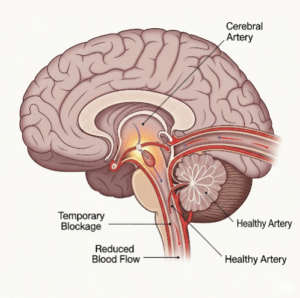Overview
Omentum cancer refers to the presence of malignant tumors in the omentum, a layer of fatty tissue in the abdomen that drapes over the stomach, intestines, and other organs. The omentum itself rarely develops cancer on its own; more often, it becomes involved through the spread (metastasis) of cancer from nearby organs such as the ovaries, stomach, colon, or pancreas. Because of its rich blood and lymphatic supply, the omentum is a common site for cancer cells to settle and grow. Omental involvement is often associated with advanced-stage cancer.
What is Omentum Cancer?
Omentum cancer typically refers to secondary (metastatic) cancer, rather than a primary tumor originating in the omentum itself. Primary omental tumors are extremely rare and may include liposarcoma, leiomyosarcoma, or mesothelioma. Most cases involve metastatic spread, particularly from:
- Ovarian cancer
- Gastrointestinal cancers (stomach, colon, pancreas)
- Endometrial or uterine cancers
Cancer cells that reach the omentum often create a condition called omental caking, where the tissue becomes thickened and studded with tumor nodules.
Symptoms
Symptoms of omentum cancer may be vague or appear only after significant disease progression. Common signs include:
- Abdominal bloating or distension
- Unexplained weight loss
- Fatigue and weakness
- Abdominal or pelvic pain
- Loss of appetite
- Ascites (accumulation of fluid in the abdomen)
- Nausea or digestive discomfort
Causes
Omentum cancer is usually caused by metastasis from other primary cancers. The most common pathways include:
- Peritoneal seeding: Cancer cells detach from a primary tumor and implant on the omentum
- Lymphatic spread: Through the lymphatic system
- Hematogenous spread: Through the bloodstream
The exact cause of the primary cancer varies, but risk factors include genetic mutations (e.g., BRCA), lifestyle factors, chronic inflammation, and environmental exposures.
Risk Factors
Risk factors for omental involvement by cancer include:
- Diagnosis of advanced-stage ovarian or gastrointestinal cancer
- Genetic predisposition (e.g., BRCA1/BRCA2 mutations)
- History of peritoneal carcinomatosis
- Late diagnosis or untreated cancer
- Prior abdominal or pelvic surgeries that altered peritoneal surfaces
Complications
If left untreated, omentum cancer can lead to serious complications, such as:
- Severe abdominal distension and discomfort
- Bowel obstruction
- Ascites and respiratory difficulty due to fluid buildup
- Malnutrition and weight loss
- Cancer cachexia (wasting syndrome)
- Systemic spread to other organs
- Reduced quality of life
Prevention
Preventing omentum cancer involves early detection and management of primary cancers before they spread. Key steps include:
- Routine cancer screenings (e.g., Pap smears, colonoscopy, pelvic exams)
- Genetic counseling and testing for high-risk individuals
- Prophylactic surgeries in high-risk genetic cases (e.g., risk-reducing oophorectomy for BRCA mutation carriers)
- Prompt treatment of known cancers
- Healthy lifestyle practices to reduce general cancer risk (balanced diet, no smoking, regular exercise)
Treatment Options in Korea
South Korea is internationally recognized for its advanced cancer care and integrated oncology programs. Treatment for omentum cancer depends on the underlying cancer type and extent of metastasis and may include:
- Cytoreductive surgery: Removal of visible tumors from the omentum and other affected tissues
- HIPEC (Hyperthermic Intraperitoneal Chemotherapy): A specialized technique that delivers heated chemotherapy directly to the abdominal cavity during surgery
- Systemic chemotherapy: To treat both local and distant cancer spread
- Targeted therapy: For cancers with specific molecular or genetic mutations
- Immunotherapy: In select cases, especially for recurrent or resistant tumors
- Palliative care: For advanced cases, to relieve symptoms and improve quality of life
Korea’s leading institutions like National Cancer Center Korea, Samsung Medical Center, and Seoul Asan Medical Center offer comprehensive cancer care, including advanced surgical procedures, molecular diagnostics, and personalized treatment protocols.













